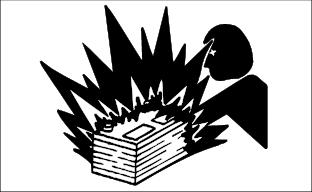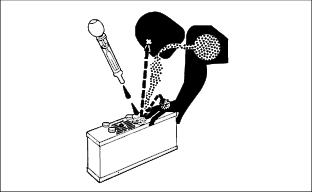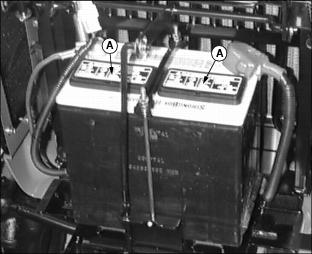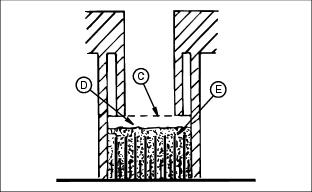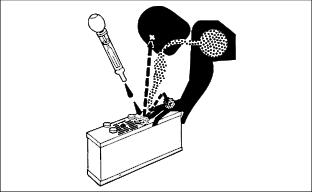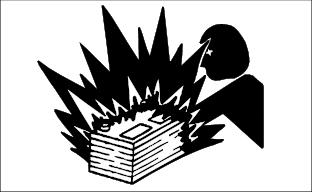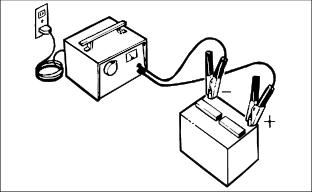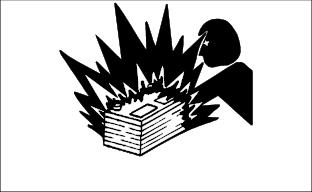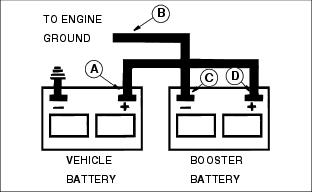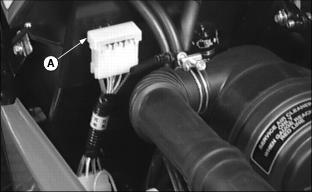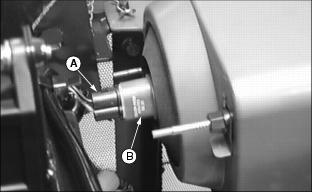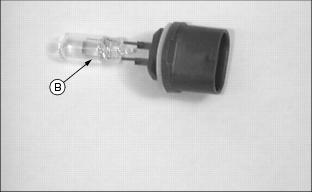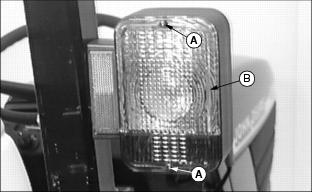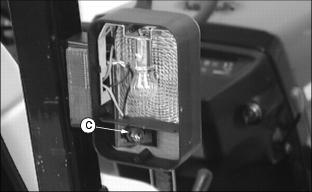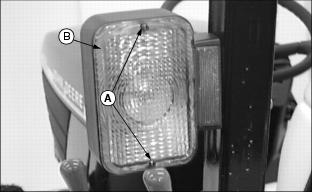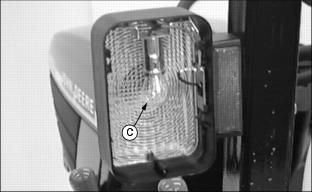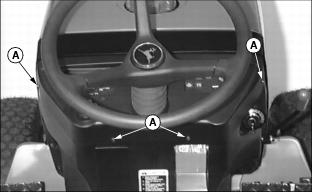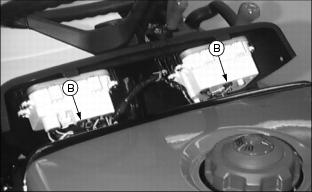Compact Utility Tractor with Gear Transmission
INTRODUCTION
SAFETY SIGNS
CONTROLS
OPERATING MACHINE
REPLACEMENT PARTS
SERVICE MACHINE SAFELY
SERVICE INTERVAL CHART
SERVICE ENGINE
SERVICE TRANSMISSION
SERVICE ELECTRICAL
Checking Battery Electrolyte Level
Replacing Instrument Panel Light Bulb
SERVICE MISCELLANEOUS
TROUBLESHOOTING
STORING MACHINE
ASSEMBLY
SPECIFICATIONS
WARRANTY
JOHN DEERE SERVICE LITERATURE
QUALITY DOESN'T END WHEN YOU INVEST IN A DEERE
CopyrightŠ Deere & Company

SERVICE ELECTRICAL
Cleaning or Replacing Battery
1. Raise and secure tractor hood into an open position. (See Opening Hood in the Operating section.)
2. Remove tractor grille. (See Removing Front Grille in the Operating section.)
3. Remove battery hold-down assembly.
ˇ Remove nuts (A) and spacers (B) to remove battery hold-down retainer (C).
4. Remove negative (black) cable (D) from the battery first.
5. Remove positive (red) cable (E).
6. If battery is very dirty, remove battery.
7. Clean battery, battery terminals, cable ends, hold-down and cover, and battery tray with a solution of 1 part baking soda to 4 parts water. Keep solution out of battery cells.
NOTE: If a new battery is required, install a replacement John Deere battery or an equivalent. (See your John Deere dealer.)
8. Rinse all parts with clean water. Let dry.
10. Connect positive (red) cable (E) to battery first, then the negative (black) cable (D).
11. Apply petroleum jelly on battery terminals to help prevent corrosion.
12. Install battery hold-down retainer.
Checking Battery Electrolyte Level
IMPORTANT: Avoid damage! DO NOT fill cells to the bottom of the filler neck (C). Electrolyte can overflow when battery is charged and cause damage. |
2. Electrolyte (D) should be 6 mm (1/4 in.) above plates (E).
3. Add distilled water if necessary.
Charging the Battery
Follow instructions on the battery charger or in the charger operator's manual, or use the instructions below as a guide.
ˇ Wait until the battery has warmed to room temperature. Do not charge a frozen battery.
ˇ Check the electrolyte level of each cell. (See Checking Battery Electrolyte Level in this section.)
ˇ Install the battery cap(s) on the battery.
Turn OFF and unplug the charger before you connect cables to the battery or disconnect cables from the battery.
If the battery becomes warm to touch during charging:
ˇ Stop charging the battery until it cools.
1. Remove and clean battery. (See Cleaning Or Replacing Battery in this section.
2. Check electrolyte level. (See Checking Battery Electrolyte Level in this section.)
3. Leave cell caps on battery while you charge it.
4. Connect positive (+) charger cable to positive (+) battery terminal.
5. Connect negative (-) charger cable to negative (-) battery terminal.
7. Charge battery. See CHARGING RATES on the next page.
8. Unplug charger cord. Remove charger cables.
Charging Rates
See your battery charger or charger operator's manual for information on charging. Or read the information below to FULLY CHARGE your battery.
For a charger with a CURRENT ADJUSTMENT CONTROL:
ˇ Charge the battery for 6-8 hours.
For a charger with a switch for MAINTENANCE FREE, DEEP CYCLE, or NORMAL (CONVENTIONAL) setting:
ˇ Use the MAINTENANCE FREE or DEEP CYCLE setting.
For a charger with SLOW CHARGE, FAST CHARGE, or BOOST CHARGE setting:
ˇ DO NOT use the BOOST CHARGE setting.
ˇ Use the SLOW CHARGE setting:
ˇ For a charger rated at less than 10 amps.
ˇ Use the FAST CHARGE setting:
ˇ For a charger rated at 10 amps.
NOTE: Your charger may have an AUTOMATIC STOP to prevent charging the battery when the battery is fully charged OR is not in condition to take a charge.
Using Booster Battery
1. Connect positive (+) booster cable to booster battery positive (+) post (D).
2. Connect the other end of positive (+) booster cable to vehicle battery positive (+) post (A).
3. Connect negative (-) booster cable to booster battery negative (-) post (C).
4. Connect the other end of negative (-) booster cable (B) to engine ground away from battery.
Replacing Fuses
IMPORTANT: Avoid damage! When replacing fuses - use the proper replacement fuse or damage to the circuit may occur. |
1. Raise and secure tractor hood into an open position. (See Opening Hood in the Operating section.)
2. Squeeze ends of fuse holder cover (A) to remove.
4. Pull defective fuse from socket.
Replacing Headlight Bulb
IMPORTANT: Avoid damage! Prevent premature failure when inspecting or replacing the headlight bulb assembly. Refrain from touching the assembly glass component with bare skin surfaces. |
1. Raise and secure tractor hood into an open position. (See Opening Hood in the Operating section.)
2. Disconnect wiring harness (A) from headlight bulb assembly (B).
3. Rotate headlight bulb assembly left 1/3 turn and remove from headlight housing socket.
4. Install new headlight bulb assembly into housing socket and rotate right 1/3 turn into a locked position.
5. Connect wiring harness to headlight bulb assembly.
6. Check lights. (See Using Light Switch in the Operating section.)
Replacing Taillight Bulb
NOTE: Taillight can be serviced by removing the front or rear assembly lens.
1. Remove two screws (A) and lens (B) from the combination warning light / taillight assembly mounted on the right side of the ROPS.
2. Pull lower bulb (C) to remove. DO NOT twist.
4. Check lights. (See Using Light Switch in the Operating section.)
Replacing Warning Light Bulb
NOTE: Warning light can be serviced by removing the front or rear assembly lens.
Light assembly on the right side of the ROPS is a combination warning light/taillight. (See Replacing Taillight Bulb in this section to determine correct warning light bulb location.)
1. Remove two screws (A) and lens (B) from the warning light assembly mounted on either side of the ROPS.
2. Turn bulb (C) left to remove.
4. Check lights. (See Using Light Switch in the Operating section.)
Replacing Instrument Panel Light Bulb
1. Remove four instrument panel attaching screws (A).
2. Carefully lift instrument panel.
3. Remove bulb holder (B) from instrument panel socket.
4. Pull defective bulb from socket. DO NOT twist.
6. Install bulb holder into instrument panel.
7. Check lights. (See Using Light Switch in the Operating section.)

